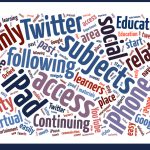 Helen Beetham has now completed a comprehensive summary of the key themes that have emerged from the Digital Learner stories. The summary takes key themes from the 12 different learners’ stories and allows the learners voices to explore each theme in turn.
Helen Beetham has now completed a comprehensive summary of the key themes that have emerged from the Digital Learner stories. The summary takes key themes from the 12 different learners’ stories and allows the learners voices to explore each theme in turn.
Highlights of the summary include the following.
- Key benefits of digital learning for these learners were inclusion, independence, and flexibility (or ‘making time‘).
- Tablets are a game-changer for many learners: convenient, lightweight and connected to all their digital services. These learners loved their tablets.
- These learners also loved some very traditional features of formal education, including libraries, the virtual learning environment, on-site IT support and fixed computing facilities.
- Confident teaching staff were critical to the positive experiences these learners had, especially when they were introducing professional practices and networks.
- New digital learning habits that learners explore in these stories include digital reading and writing, note-making, curation, learning from video and other media, sharing, coding and making.
- These learners responded to digital learning with feelings of curiosity, enthusiasm, excitement, freedom and a sense of fun. However, they also wanted their digital learning to be safe and for other learners to be respectful in digital spaces.
- For some of these learners, digital technology represented a ‘second chance’ or even ‘the only chance’ that they had to engage with education.
- Some of these learners are mixing public and private spaces (such as learning groups and professional networks). Others engage in formal and informal learning in tandem. These are confident digital behaviours that not all learners will feel happy to try.
- Most but not all of these learners saw their digital skills as assets for work.
In her conclusion Helen writes:
There are many continuities in the stories learners tell. As in the pre-digital age, learners still need access to rich resources, opportunities to practice, and supportive interactions with their tutors and peers. They make notes, organise ideas, prepare assignments, collaborate, express themselves, manage their time and motivation, revise and review, listen to feedback and showcase what they can do. But there are also some striking discontinuities. Learners are making more use of graphical, video and audio resources, both to learn and to express what they can do. They curate their personal learning resources in ways that were unimaginable in the days of paper. They share, comment, mix, remix and repurpose freely. They use digital networks to connect across boundaries, whether the barriers between learning and work, or between learners in different countries, or between formal learning and all the other opportunities and interests they have.
Increasingly, learners expect their digital skills to be a resource for getting on in life, and getting an education. They have innovative learning habits of their own, and they have creative ideas about how educators could better support them. Through stories like these we are learning to listen.
You can download the summary (PDF) here. The stories and the videos that accompany them are useful resources in their own right. Use them to open up discussions about staff-student partnerships, institutional provision of IT, digital skills support and much more.
